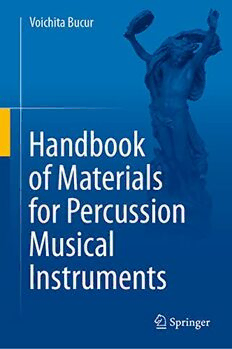Table Of ContentVoichita Bucur
Handbook
of Materials
for Percussion
Musical
Instruments
Handbook of Materials for Percussion Musical
Instruments
Voichita Bucur
Handbook of Materials
for Percussion Musical
Instruments
VoichitaBucur
SchoolofScience
RMITUniversity
Melbourne,VIC,Australia
ISBN 978-3-030-98649-0 ISBN 978-3-030-98650-6 (eBook)
https://doi.org/10.1007/978-3-030-98650-6
©TheEditor(s)(ifapplicable)andTheAuthor(s),underexclusivelicensetoSpringerNature
SwitzerlandAG2022
Thisworkissubjecttocopyright.AllrightsaresolelyandexclusivelylicensedbythePublisher,whether
thewholeorpartofthematerialisconcerned,specificallytherightsoftranslation,reprinting,reuse
ofillustrations,recitation,broadcasting,reproductiononmicrofilmsorinanyotherphysicalway,and
transmissionorinformationstorageandretrieval,electronicadaptation,computersoftware,orbysimilar
ordissimilarmethodologynowknownorhereafterdeveloped.
Theuseofgeneraldescriptivenames,registerednames,trademarks,servicemarks,etc.inthispublication
doesnotimply,evenintheabsenceofaspecificstatement,thatsuchnamesareexemptfromtherelevant
protectivelawsandregulationsandthereforefreeforgeneraluse.
Thepublisher,theauthorsandtheeditorsaresafetoassumethattheadviceandinformationinthisbook
arebelievedtobetrueandaccurateatthedateofpublication.Neitherthepublishernortheauthorsor
theeditorsgiveawarranty,expressedorimplied,withrespecttothematerialcontainedhereinorforany
errorsoromissionsthatmayhavebeenmade.Thepublisherremainsneutralwithregardtojurisdictional
claimsinpublishedmapsandinstitutionalaffiliations.
ThisSpringerimprintispublishedbytheregisteredcompanySpringerNatureSwitzerlandAG
Theregisteredcompanyaddressis:Gewerbestrasse11,6330Cham,Switzerland
Preface
Handbook of Materials for Percussion Musical Instruments follows my previous
twobookspublishedbySpringerin2016onstringinstrumentsandin2019onwind
instruments and is related to the materials for percussion instruments used in the
symphony orchestras. The scope of this book is primarily confined to percussion
instruments of the symphony orchestras, but I also take account of centuries of
musicalartandtradition.WiththisvolumeIintended,tothebestofmyability,to
bridge the existing gap in the technical literature relating to the description of the
propertiesofmaterialsforpercussioninstruments—timpani,otherdrums,marimba,
xylophone,vibraphone,gong,cymbal,triangle,celesta,castanets,etc.AsImentioned
in the prefaces of the previous two books on this subject, the idea of connecting
materialsciencewiththespecificpropertiesofmaterialsusedformusicalinstruments
becamearealityfollowingmylongconversationsin2011withDr.GrahameSmithat
CSIRO—CommonwealthScientificandIndustrialResearchOrganisation—Material
ScienceLaboratoryinClayton,locatednearMelbourne,inAustralia.
Iwouldliketomentionthattheorganologicstudyofmusicalinstrumentscannot
bedissociatedfromthestudyofthephysicsofthemusicalinstrumentsbecauseof
thesoundstheinstrumentsproducedwhich,inturn,cannotbedissociatedfromthe
studyofmaterialsciencerelatedtothematerialsfromwhichtheyaremade.Thegoal
ofthisbookistosuggestwaysofcombiningtheseparalleldevelopmentshavingin
mindthattheconstructionofmusicalinstrumentsrequiresstudyofthecorresponding
materialsatdifferentlevelsofcomplexity.Beingoneoftheoldestfamilyofmusical
instruments, the percussion instruments can be classified using various schemes:
one is using the means by which the sound is produced—the instruments are the
membranophones and the idiophones, by the traditional musical division into two
groups, the pitched and the unpitched instruments, by the way of playing—with
malletsorbyhands,orbyculturaltradition—theinstrumentsbeingEuropean,Latin
American,African,Asian,etc.Physicalcriteriafortheclassificationofpercussion
instrumentsofthesymphonyorchestraarethepitch,themodeofvibration,theshape
ofvibratingbodies,thenatureofthematerialsused(wood,metal,skin),thetypeof
excitation,etc.
v
vi Preface
The family of percussion musical instruments is probably the oldest existing
familyofmusicalinstrumentsandincludesnumerousinstrumentsmadeofalarge
varietyofmaterialshavinginstrumentsofalargevarietyofsizesandtimbres.Over
centuries,somepercussioninstruments,likethetimpani,underwentimportanttech-
nicalimprovementwhileotherslikethetambourinehavemaintainedthesameshape
from antiquity. It is worth mentioning that new percussion instruments have been
invented in the second half of the XXth century using metallic materials for their
manufacturing.
Traditionally, the following materials have been used for the manufacturing of
percussioninstruments:woodforidiophoneslikemarimbaandxylophone,metallic
materialsforthestruckidiophonesplayedwithmalletslikethegong,cymbal,tubular
bell,andtriangle,leatherforthemembranesofthedrumsandofcoursenewmaterials
becameavailable,especiallyduringthesecondhalfoftheXXthcentury.Thisbook
has twenty chapters and is structured in four parts. The first part deals with the
classificationofpercussioninstruments,thesecondpartdescribesthestructuralparts
of the instruments, the third part is related to the properties of materials and the
fourth part deals with the maintenance and conservation procedures of percussion
instruments.
The elaboration of this volume took several years and was possible, thanks to
my association in Melbourne with RMIT University, School of Science, Acoustic
Research group directed by Prof. John Davy and thanks to the access given to the
libraryoftheRMITUniversityandthegeneroushelpofitsscholars.
ThemanuscriptofthisbookwastechnicallyrevisedbyDr.GrahameSmithwho
continuouslyandenthusiasticallyencouragedmeforover10yearstofinishthefirst,
thentheseconddraftandthenthethirddraftofthemanuscriptofthisbook,reading
andcommentingonabout2000pagesofeachdraft.IamverygratefultoDr.Grahame
Smithforhisenthusiasticsupportoversomanyyears.
IamalsoverygratefultoMr.LenTosoliniforkindlyproofreadingthedraftsof
thismanuscriptoversomanyyears.
I am very grateful to Dr. Cathy Foley AO PSM, Australia’s chief scientist. My
work on three books published by Springer related to the materials for musical
instrumentswasalabouroflovethatshesponsoredwhenasChiefoftheDivisionof
MaterialScienceandEngineeringatCSIRO(CommonwealthScientificandIndus-
trialResearchOrganisation—Australia)shechampionedthisprojectandprovideda
supportiveworkenvironment
For their contribution with comments, documents, figures, unpublished results,
etc., helping to improve the manuscript of this book, I would like to address my
warmacknowledgmentstoDr.MarianaDomnicaStanciu—UniversityTransylvania
Brasov, Romania, Dr. José Antunes—Universidade Nova de Lisboa, Portugal, Dr.
VincentDebut—UniversidadeNovadeLisboa,Portugal,Dr.JoâoCarvalho,Faculty
ofHumanSciencesUniversidadeNovadeLisboa,Portugal,M.PeterD.R.Bond,
retired Director of the Projects Directorate, European Investment Bank, Luxem-
bourg, Dr. Jean Marie Heinrich—Mulhouse, France, Dr. Adrian Hapca, Scotland,
Prof. Lamberto Tronchin, University of Bologna, Italy, Prof. Cyril Touzé—Ecole
Preface vii
Polytechnique,Paris,France,MmeElisabethWiss,MuseumofMusicalInstruments,
Paris.
I owe a debt of gratitude to colleagues in musical acoustics and in mate-
rials science, musical instrument makers, scientific organisations, museums and
publisherscitedinthereferencelistsfortheirpermissiontoreprintfiguresandother
data.Thisbookisinfactarecordoftheworkofmanyresearcherswhohavestudied
percussion instruments and the materials fromwhich they are made. Due to space
limitations,Ihavebeenobligedtobeselective,andmanyinterestingancillarytopics
havenotbeentreatedindepth.
ForthepublicationofthisbookbySpringer,Iacknowledgethecontributionof
Dr.MayraCastroandthetechnicalstaffinvolvedintheproductionofthisbook.
I am very grateful to my sister, Despina Bucur Spandonide, architect, for her
cheerfulencouragementandsupportduringthemanyyearsneededforthecompletion
ofthisbook.Shegavemesupportthroughinterestingdiscussionsabouttherepresen-
tationofpercussioninstrumentsinGreekart.Shecontributedwithherbackground
totheinsertioninthisbookofnumerousimagesofworksofart.
Ihopethatthisbookwillbeofinterestandofassistancetoreadersapproaching
thissubjecteitherasaconcisesurveyofthesubject,orbyusingtheindexforspecific
topics,andIhopeitwillgeneratenewideasforfurtherresearch.
Melbourne,Australia VoichitaBucur
January2022
Contents
PartI PercussionInstruments,TheirClassificationandTheir
Sound
1 Introduction ................................................. 3
1.1 TheBackground ........................................ 3
1.1.1 DescriptionofPercussionInstruments .............. 8
1.1.2 TheFrequencyRangeofPercussionInstruments ..... 16
1.1.3 TheLayoutPlanofPercussionInstruments
inaSymphonyOrchestra ......................... 17
1.1.4 AbouttheMusicalWorksIncludingPercussion
Instruments ..................................... 19
1.1.5 Summary ....................................... 25
1.2 ThePurposeoftheBook ................................. 27
Appendix1.1 ................................................. 27
Appendix1.2 ................................................. 32
Appendix1.3 ................................................. 34
Appendix1.4 ................................................. 35
Appendix1.5 ................................................. 36
References ................................................... 38
2 Organology of Percussion Instruments for the Classic
SymphonyOrchestra ......................................... 41
2.1 Introduction ............................................ 41
2.1.1 IconographicRepresentationofPercussion
InstrumentsforEarlyMusic ....................... 43
2.1.2 Written Documents About Percussion
InstrumentsforEarlyMusic ....................... 45
2.2 HistoricalEvolutionofMembranophonePercussion
Instruments ............................................. 65
2.2.1 TheTimpani .................................... 65
2.2.2 TheSnareDrum ................................. 89
2.2.3 TheBassDrum .................................. 90
ix
x Contents
2.3 Historical Evolution of Idiophone Percussion
Instruments ............................................. 90
2.4 Summary .............................................. 94
Appendix2.1 ................................................. 95
Appendix2.2 ................................................. 96
Appendix2.3 ................................................. 97
References ................................................... 99
3 AbouttheSoundofPercussionInstruments .................... 103
3.1 Introduction ............................................ 103
3.2 VibrationofBars ........................................ 105
3.3 VibrationofPlates ....................................... 110
3.3.1 RectangularPlates ............................... 110
3.3.2 CircularPlates .................................. 110
3.4 VibrationofMembranes .................................. 112
3.5 VibrationofShells ...................................... 125
3.6 ImpactSoundsofPercussionInstrumentsandtheEffects
ofMaterialsonTheseSounds ............................. 129
3.6.1 Physical and Mechanical Properties
oftheSoundSources ............................. 130
3.6.2 EffectofContactStiffnessonVibrationModes
ofBars ......................................... 131
3.6.3 AbouttheImpactSoundonBarsandPlates
MadeofWood .................................. 133
3.6.4 Impact Sound on Bars and Plates Made
ofVariousMaterials .............................. 146
3.6.5 About Sound of Percussion Instruments
andtheVibrationofMembranes ................... 150
3.6.6 AbouttheSoundofPercussionInstruments
andtheVibrationofShells ........................ 162
3.7 Summary .............................................. 170
Appendix3.1 ................................................. 172
Appendix3.2: WoodAnatomy ............................... 172
Appendix3.3: ListofWoodSpeciesCitedinthisChapter ........ 183
References ................................................... 184
4 MethodologyforPercussionInstrumentsTesting ................ 189
4.1 Introduction ............................................ 189
4.2 ModesofVibrationofPercussionInstrumentsandFinite
andBoundaryElementStudies ............................ 190
4.3 Experimental Studies on Modes of Vibration
ofPercussionInstruments ................................ 191
4.3.1 Modal Testing with the Response
oftheStructureMeasuredMechanically ............ 191
4.3.2 OpticalInterferometry,asaNoncontactMethod
forModalTesting ................................ 204
Contents xi
4.4 NumericalSimulationofPercussionInstruments ............. 233
4.4.1 NumericalMethodsintheTimeandFrequency
Domain–GeneralAspects ......................... 234
4.4.2 Modal Behaviour of a Drum with One
Membrane—TheTimpani ......................... 235
4.4.3 Modal Behaviour of a Drum with Two
Membranes,theTom-Tom ........................ 237
4.4.4 ModalBehaviourofaBowedBar .................. 240
4.4.5 InteractionBetweenBarandMallet ................ 251
4.5 ImprovementintheDesignofPercussionInstruments ........ 257
4.5.1 TheBarsofaXylophone ......................... 258
4.5.2 TheShellofaSnareDrum ........................ 259
4.6 Summary .............................................. 265
Appendix4.1 ................................................. 266
Appendix4.2 ................................................. 268
References ................................................... 270
PartII StructuralPartsoftheInstruments
5 Materials for Membranophones—Timpani, Drums,
Tambourine ................................................. 279
5.1 Introduction ............................................ 279
5.2 Timpani ................................................ 280
5.2.1 StructuralPartsoftheTimpani ..................... 280
5.2.2 MaterialsfortheTimpani ......................... 283
5.2.3 Technological Aspects of Manufacturing
oftheKettle ..................................... 284
5.3 TheSnareDrum ........................................ 295
5.3.1 StructuralPartsoftheSnareDrum ................. 300
5.3.2 MaterialsfortheSnareDrum ...................... 301
5.3.3 Technological Aspects of Snare Drum
Manufacturing .................................. 308
5.4 BassDrum ............................................. 315
5.4.1 StructuralPartsoftheBassDrum .................. 315
5.4.2 MaterialsfortheBassDrum ....................... 317
5.4.3 Technological Aspects of Bass Drum
Manufacturing .................................. 319
5.4.4 EffectofThermo-Hydro-MechanicalTreatment
onWoodStructure ............................... 319
5.5 TheTambourine ........................................ 325
5.5.1 DescriptionoftheTambourine ..................... 325
5.5.2 MaterialsforTambourines ........................ 329
5.5.3 AReplicaofaTambourineoftheXVthCentury ..... 329
5.6 Summary .............................................. 329
References ................................................... 334

